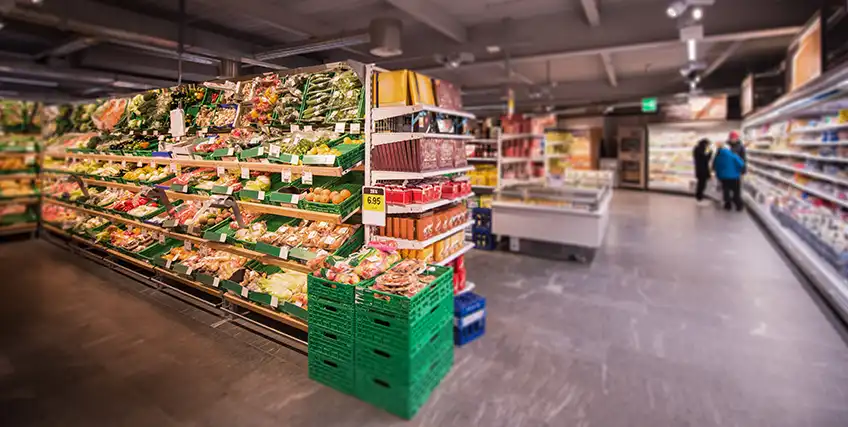How to Start a Grocery Store
April 01, 2025 | Last Updated on: April 02, 2025

How to Get a Grocery Store Open: A Comprehensive Guide
Getting a grocery store open can be a profitable business venture, but it requires careful planning, significant investment, and hard work. Before you open a small business of any kind, you’ll need to be prepared for all the work getting it open will require.
In this guide, we’ll walk you through the essential steps for how to start a grocery store business, from initial planning to grand opening.
1. Develop a Business Plan
Before you start to open a small business, having a clear and concise business plan is crucial. A well-structured business plan serves as a roadmap for your store’s growth and sustainability. It should detail every aspect of your business, including goals, strategies, and financial projections.
How to Start a Grocery Store Business Plan:
- Executive Summary: Briefly summarize your store's vision, mission, and objectives. It should answer questions like: What type of grocery store will you open? What makes it different from others? Who will be your target customers?
- Market Research: Conduct thorough research to understand the grocery market in your area. Who are your competitors? Are there other grocery stores nearby? What can you offer that they do not? Market research helps you identify your customer base and the demand for your store.
- Target Market: Your target market is a crucial part of your business plan. Identify whether you are serving families, individuals, health-conscious consumers, or specific dietary groups (e.g., organic, gluten free, etc.). Knowing your audience will guide your inventory choices, pricing strategy, and marketing efforts.
- Store Concept and Design: What will your grocery store look like? Will you offer a full range of products or specialize in specific categories (such as organic produce, local products, or international foods)? The store design should align with your target market and offer convenience and accessibility to customers.
- Financial Plan: Outline your startup costs, projected expenses, and expected revenue. Include a break-even analysis and how you plan to finance your business (personal savings, loans, investors, etc.). It’s important to have a clear understanding of your capital needs and a detailed cash flow plan for how to start a grocery store.
2. Secure Financing to Get Your Grocery Store Open
Getting your grocery store open requires significant capital, as you need to cover costs such as store lease, inventory, equipment, and staff salaries. Securing financing is one of the first steps to open a small business.
Sources of Financing:
- Personal Savings: Many entrepreneurs start with their own savings to fund the business. This approach avoids debt but may limit your initial funding.
- Bank Loans: If you need more capital, applying for a business loan can provide the necessary funds. A strong business plan, good credit score, and a solid financial strategy are essential to secure a loan.
- Investors: You can also seek investors who are interested in funding your grocery store in exchange for equity. Investors bring not only capital but also expertise and networking opportunities.
- Crowdfunding: Some entrepreneurs turn to crowdfunding platforms like Kickstarter or GoFundMe to raise money for their store. This approach is typically used for niche or specialty stores.
3. Find a Location
The location of your grocery store is one of the most important factors for success. It must be convenient and accessible to your target customers. Selecting the right location requires research and careful consideration of several factors.
Factors to Consider When Choosing a Location:
- Demographics: Choose a location where your target customers live or work. If you’re aiming at families, look for areas with a high percentage of households with children. If your target is health-conscious shoppers, consider proximity to gyms, parks, or affluent neighborhoods.
- Foot Traffic and Visibility: A location with high foot traffic, such as near a busy street or a shopping center, is ideal. Visibility is key for drawing in customers who might not have heard of your store.
- Competitors: Research the competition in the area. Are there large grocery chains or other independent stores nearby? Analyze what they offer and how you can differentiate your store.
- Size and Layout: Your store needs enough space for shelves, refrigerators, storage, and checkout counters. A convenient layout helps with customer flow, ensuring ease of shopping and minimizing congestion.
- Lease Terms and Rent: Evaluate the lease terms carefully. Make sure the rent is reasonable for the area and understand any lease renewal clauses and restrictions. Also, consider factors such as parking and public transport accessibility for your customers.
4. Register Your Business and Obtain Necessary Permits
Once you’ve chosen a location to get your grocery store open, it’s time to legally establish your business. This involves registering your business and obtaining the necessary permits and licenses.
Steps to Register Your Business:
- Business Name Registration: Choose a unique name for your store and register it with your local authorities. Ensure that the name is not already in use by checking your state or country’s business registry.
- Business Structure: Decide whether your grocery store will be a sole proprietorship, partnership, LLC, or corporation. The structure you choose will affect your liability, taxes, and business operations.
- Tax Identification Number (TIN): Apply for an Employer Identification Number (EIN) from the IRS or your country’s equivalent. This number is needed for tax purposes and to open a business bank account.
- Permits and Licenses: You will need several licenses and permits to legally operate your grocery store. These may include:
- Business license: Required to operate legally in your locality.
- Health permits: Since you're handling food, you'll need health department approval to ensure that your store meets food safety regulations.
- Food handling certifications: Some areas require employees who handle food to have certifications in food safety.
- Sales tax permit: If your state or country requires sales tax, you’ll need to apply for a permit to collect taxes from customers.
5. Design and Set Up the Store
The store’s layout and design should create a positive shopping experience for your customers while promoting easy access to the products they need. It’s important to think about both functionality and aesthetics as you get your grocery store open.
Key Design Considerations:
- Store Layout: The layout should create a natural flow, guiding customers through the aisles in a way that encourages them to explore different sections. Place high-demand items like milk, eggs, and bread near the back of the store so customers pass through other sections, increasing sales.
- Shelving and Equipment: Invest in sturdy shelving, refrigerators, and freezers to properly display and store your inventory. Your point-of-sale (POS) system should be user-friendly for efficient checkout, and you’ll need cash registers, scanners, and credit card machines.
- Interior Décor: A welcoming and clean environment is essential for attracting customers. The lighting, signage, and overall aesthetics of the store should reflect the vibe of your brand, whether it's modern, rustic, or eco-friendly.
- Inventory: Stocking your shelves with the right mix of products is key to success. You’ll need a variety of staple grocery items like produce, meats, dairy, and packaged goods. If you’re targeting niche markets, such as organic foods or international ingredients, make sure to source products accordingly.
6. Hire and Train Staff
Hiring the right staff is vital for your store’s success. Your employees will interact with customers daily, and their behavior will directly impact customer satisfaction.
Key Considerations for Hiring Staff:
- Customer Service: Hire employees who have good communication skills and can provide excellent customer service. They should be helpful, knowledgeable, and friendly.
- Training: All employees must be trained in food safety practices, how to operate the POS system, and how to properly stock and handle inventory. Regularly update your team on new products, promotions, and store policies.
- Payroll and Scheduling: Set up a payroll system to manage salaries, taxes, and benefits. Use scheduling software to ensure your store is adequately staffed during busy periods.
7. Market Your Grocery Store Open
Once your store is ready to open, you need to generate awareness and attract customers. A strong marketing strategy will help you establish your brand and build customer loyalty.
Marketing Ideas for Your Grocery Store Open:
- Grand Opening: Host a grand opening event with discounts, product samples, and giveaways to entice customers to visit your store. This is a great way to build excitement and generate word-of-mouth promotion.
- Social Media: Create social media accounts for your store (Facebook, Instagram, Twitter) and regularly post content such as promotions, new arrivals, and recipes. Social media is a powerful tool to engage with your customers and reach a wider audience.
- Loyalty Programs: Offer a loyalty or rewards program to encourage repeat business. This could include discounts, special offers, or points for every dollar spent.
- Local Advertising: Advertise your store in local newspapers, magazines, and radio stations. Consider partnering with other local businesses for cross-promotions to expand your reach.
8. Ensure Compliance with Health and Safety Regulations
Complying with health and safety regulations is non-negotiable in the food retail business. It’s essential to follow local, state, and national guidelines to ensure the safety of your products and your customers.
Compliance Areas:
- Food Safety: Follow guidelines for food storage, handling, and sanitation to prevent contamination and ensure customer safety.
- Employee Safety: Adhere to safety protocols for your staff, including proper handling of equipment, emergency exits, and fire prevention.
- Regular Inspections: Your store will be subject to inspections from health and safety officials. Make sure your store is always up to code to avoid fines or penalties.
9. Get Your Grocery Store Open and Monitor Progress
After months of planning and preparation, it’s time to open your grocery store. Market your grocery store grand opening an event to attract customers and generate buzz.
After the Grocery Store Opens:
- Monitor Sales: Keep track of your sales data and customer feedback. This will help you make informed decisions on inventory, pricing, and promotions.
- Customer Feedback: Always listen to your customers’ needs and concerns. Adapt your product offering or services based on their preferences.
Final Thoughts on Getting a Grocery Store Open
Getting a grocery store open is a complex but rewarding venture. By carefully planning your business, securing financing, choosing the right location, and providing excellent customer service, you can create a successful grocery store that thrives in the competitive market. With dedication, strategy, and perseverance, your grocery store can become a valued part of your community for years to come.
FAQs About Getting a Grocery Store Open
What is an executive summary for getting a grocery store open?
One of the steps to open a small business is creating an executive summary. This should summarize your store's vision, mission, and objectives. It should answer questions like: What type of grocery store will you open? What makes it different from others? Who will be your target customers?
What are some marketing ideas to get a grocery store open?
Creating awareness through social media is an effective marketing strategy to open a small business. Other marketing strategies include having a grand opening, local advertising, and building a loyalty program to establish a customer base.
Does a startup need a Tax ID number?
Yes, one of the steps to open a small business includes applying for an Employer Identification Number (EIN) from the IRS or your country’s equivalent. This number is needed for tax purposes and to open a business bank account.
How should you create a financial plan to get a grocery store open?
Outline your startup costs, projected expenses, and expected revenue. Include a break-even analysis and how you plan to finance your business (personal savings, loans, investors, etc.). It’s important to have a clear understanding of your capital needs and a detailed cash flow plan for how to start a grocery store.
How important is location for getting a grocery store open?
The location of your grocery store is one of the most important factors for success. It must be convenient and accessible to your target customers. Selecting the right location requires research and careful consideration of several factors.




